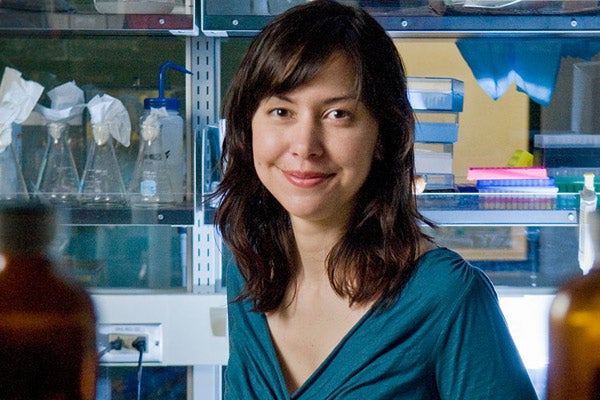|
September 16, 2014
Stanford bioengineers develop a toolkit for designing more successful synthetic molecules
Synthetic molecules hold great potential for revealing key processes that occur in cells, but the trial-and-error approach to their design has limited their effectiveness. Christina Smolke introduces a computer model that could provide better blueprints for building synthetic genetic tools. By Bjorn Carey

A team of researchers led by Christina Smolke, associate professor of bioengineering, has introduced a computer model that could provide a better way to design synthetic molecules. (Photo: Linda A. Cicero / Stanford News Service)
Ever since Robert Hooke first described cells in 1665, scientists have been trying to figure out what is going on inside. One of the most exciting modern techniques involves injecting cells with synthetic genetic molecules that can passively report on the cell's behavior, or even alter its function.
A new computer model developed by Stanford engineers could not only improve the sensitivity and success of these synthetic molecules, but also make them easier to design in the first place.
The work is detailed in the current issue of Nature Methods.
Typically, scientists have built synthetic molecules through trial and error. This approach has allowed some interesting developments, said Christina Smolke, senior author on the paper and an associate professor of bioengineering at Stanford, but it inhibits forward engineering approaches, which ultimately limits the potential of the tool.
"You start with an idea of what you want to do in the cell, and then you build and iterate on a design over and over until you reach something close to what you want," Smolke said. "As we design and build more sophisticated systems, we will want the ability to efficiently achieve precise quantitative behaviors, and being able to accurately predict relationships between the system inputs and outputs are important to achieving this goal."
The model helps devise synthetic versions of microRNA, or miRNA. In nature, these small strips of genetic code help regulate gene expression. At a basic level, a synthetic miRNA circuit might be designed to measure the level of molecule X being produced by the cell, then decrease the expression of the target gene by Y percent to achieve a desired Z behavior.
Rather than piece together molecules, test the outcome, refine the design and repeat the experiment, Smolke's model solves a series of differential equations that represent the different biochemical steps, rates and parameters you're hoping to measure within the cell, and the action you plan for your molecule to take. Based on these inputs and outputs, the model then recommends a series of molecules and steps to assemble your desired miRNA tool.
The researchers validated the process by designing a synthetic miRNA, from scratch, to monitor activity of a protein in the Wnt signaling pathway. When the concentration of the target protein produced by the Wnt pathway, beta catenin, reached a certain level, the synthetic miRNA would trigger another molecule in the cell that would cause it to fluoresce.
The Wnt pathway is well-studied – it plays a key role in embryonic development, stem cell renewal and cancer progression – so it provided a good standard to test the model against.
"When we're looking at Wnt activation, we're talking about a two- to three-fold increase in production of beta catenin," Smolke said. "That's a relatively small change in concentration and provided a nice test case for the sensitivity of these biosensors. And the nice thing about it is that it's non-invasive, you don't have to break open cells."
The algorithms are ready to be used in the lab for experiments conducted in cell culture and animal models immediately, she said, particularly for the study of cancer or the development of vaccines or stem cell therapies.
The new work was co-authored by Ryan Bloom, who was a bioengineering graduate student in Smolke's lab and is now the president of a biomedical startup, Factor 14, and Sally Winkler, who was an undergraduate research student in Smolke's group and is currently pursuing her doctorate in bioengineering through a joint program by the University of California, Berkeley and the University of California, San Francisco.
-30-
|